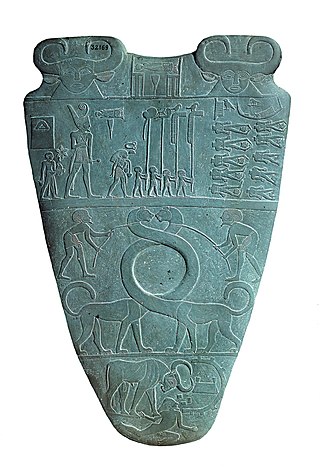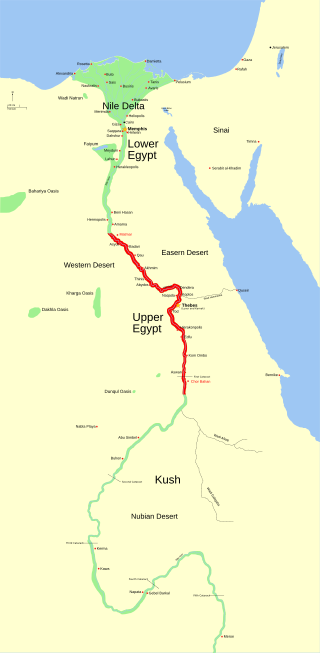Upper Egypt is the southern portion of Egypt and is composed of the Nile River valley south of the delta and the 30th parallel N. It thus consists of the entire Nile River valley from Cairo south to Lake Nasser.
Nubians are a Nilo-Saharan ethnic group indigenous to the region which is now Northern Sudan and Southern Egypt. They originate from the early inhabitants of the central Nile valley, believed to be one of the earliest cradles of civilization. In the southern valley of Egypt, Nubians differ culturally and ethnically from Egyptians, although they intermarried with members of other ethnic groups, especially Arabs. They speak Nubian languages as a mother tongue, part of the Northern Eastern Sudanic languages, and Arabic as a second language.

The prehistory of North Africa spans the period of earliest human presence in the region to gradual onset of historicity in the Maghreb during classical antiquity. Early anatomically modern humans are known to have been present at Jebel Irhoud, in what is now Morocco, approximately 300,000 years ago. The Nile Valley region, via ancient Egypt, contributed to the Neolithic, Bronze Age and Iron Age periods of the Old World, along with the ancient Near East.

Kerma was the capital city of the Kerma culture, which was located in present-day Sudan at least 5,500 years ago. Kerma is one of the largest archaeological sites in ancient Nubia. It has produced decades of extensive excavations and research, including thousands of graves and tombs and the residential quarters of the main city surrounding the Western/Lower Deffufa.

Prehistoric Egypt and Predynastic Egypt span the period from the earliest human settlement to the beginning of the Early Dynastic Period around 3100 BC, starting with the first Pharaoh, Narmer for some Egyptologists, Hor-Aha for others, with the name Menes also possibly used for one of these kings.

The Kerma culture or Kerma kingdom was an early civilization centered in Kerma, Sudan. It flourished from around 2500 BC to 1500 BC in ancient Nubia. The Kerma culture was based in the southern part of Nubia, or "Upper Nubia", and later extended its reach northward into Lower Nubia and the border of Egypt. The polity seems to have been one of a number of Nile Valley states during the Middle Kingdom of Egypt. In the Kingdom of Kerma's latest phase, lasting from about 1700 to 1500 BC, it absorbed the Sudanese kingdom of Sai and became a sizable, populous empire rivaling Egypt. Around 1500 BC, it was absorbed into the New Kingdom of Egypt, but rebellions continued for centuries. By the eleventh century BC, the more-Egyptianized Kingdom of Kush emerged, possibly from Kerma, and regained the region's independence from Egypt.
The Badarian culture provides the earliest direct evidence of agriculture in Upper Egypt during the Predynastic Era. It flourished between 4400 and 4000 BC, and might have already emerged by 5000 BC.

The Merimde culture was a Neolithic culture in the West Nile Delta in Lower Egypt, which corresponds in its later phase to the Faiyum A culture and the Badari culture in Predynastic Egypt. It is estimated that the culture evolved between 4800 and 4300 BC. Merimde also refers to the archaeological site of the same name.
The following is a chronicle of predynastic and ancient Egyptian foreign contacts up through 343 BC.

Naqada III is the last phase of the Naqada culture of ancient Egyptian prehistory, dating from approximately 3200 to 3000 BC. It is the period during which the process of state formation, which began in Naqada II, became highly visible, with named kings heading powerful polities. Naqada III is often referred to as Dynasty 0 or the Protodynastic Period to reflect the presence of kings at the head of influential states, although, in fact, the kings involved would not have been a part of a dynasty. In this period, those kings' names were inscribed in the form of serekhs on a variety of surfaces including pottery and tombs.
The A-Group culture was an ancient culture that flourished between the First and Second Cataracts of the Nile in Lower Nubia. It lasted from c. 3800 BC to c. 3100 BC.
The Amratian culture, also called Naqada I, was an archaeological culture of prehistoric Upper Egypt. It lasted approximately from 4000 to 3500 BC.

The Naqada culture is an archaeological culture of Chalcolithic Predynastic Egypt, named for the town of Naqada, Qena Governorate. A 2013 Oxford University radiocarbon dating study of the Predynastic period suggests a beginning date sometime between 3,800 and 3,700 BC.

Nubia is a region along the Nile river encompassing the area between the first cataract of the Nile and the confluence of the Blue and White Niles, or more strictly, Al Dabbah. It was the seat of one of the earliest civilizations of ancient Africa, the Kerma culture, which lasted from around 2500 BC until its conquest by the New Kingdom of Egypt under Pharaoh Thutmose I around 1500 BC, whose heirs ruled most of Nubia for the next 400 years. Nubia was home to several empires, most prominently the Kingdom of Kush, which conquered Egypt in the eighth century BC during the reign of Piye and ruled the country as its 25th Dynasty.

Egypt has a long and involved demographic history. This is partly due to the territory's geographical location at the crossroads of several major cultural areas: North Africa, the Middle East, the Mediterranean and Sub-Saharan Africa. In addition, Egypt has experienced several invasions and being part of many regional empires during its long history, including by the Canaanites, the Ancient Libyans, the Assyrians, the Kushites, the Persians, the Greeks, the Romans, and the Arabs.

The Nile River is a major resource for the people living along it, especially thousands of years ago. The El Salha Archaeological Project discovered an abundance of evidence of an ancient boat that traveled the Nile River dating back to 3,000 years ago. Pictographs and pebble carvings were uncovered, indicating a boat more advanced than a simple canoe. This evidence of a progressed Nile boat includes a steering system which may have been used in the Nile for fishing and transportation.

The civilization of ancient Egypt was indebted to the Nile River and its dependable seasonal flooding. The river's predictability and fertile soil allowed the Egyptians to build an empire on the basis of great agricultural wealth. Egyptians are credited as being one of the first groups of people to practice agriculture on a large scale. This was possible because of the ingenuity of the Egyptians as they developed basin irrigation. Their farming practices allowed them to grow staple food crops, especially grains such as wheat and barley, and industrial crops, such as flax and papyrus.
Gebel Ramlah is a region in the Western Desert of southern Egypt that was occupied throughout the African Pastoral Neolithic. Archaeological research has focused primarily on individual burial sites and six pastoral cemeteries, including the earliest known infant cemetery in the world. The Gebel Ramlah cemeteries were active during the Final Neolithic in the fifth millennium BC. Ongoing excavation has uncovered over 200 human burials and elaborate grave goods. Research studies have been done on the pottery, mollusk shells, archaeobotanical remains, and skeletal remains found throughout the sites.

Black-topped pottery is a specialized type of Ancient Egyptian pottery that was found in Nubian archaeological sites, including Elephantine, an island on the Nile River, Nabta Playa in the Nubian Desert, and Kerma in present-day Sudan. This type of artifact dates predominantly to the Predynastic Period, but “a handful of examples made in the Early Dynastic Period are known to exist.” These vessels were used “exclusively for ritual and funerary purposes” and were discovered in ancient cemeteries and settlements. The majority of these pots are variations of the Egyptian hes-jar form and feature red bodies with black tops and interiors. The red color is derived from the natural iron that occurs within Nile silts which oxidizes upon firing, and the black top and interior is a product of reduction firing and carbon smudging.
Merimde Beni Salama is a Neolithic settlement in Egypt, in the West delta of the Nile, 45 km northwest of Cairo. It is the typesite of Merimde culture. The settlement was occupied for about 800 years, from around 5000 to 4200 BC. The population may have reached as many as 16,000. The site represents the earliest evidence for a fully sedentary settlement in the Nile valley.













